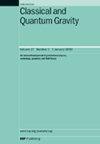揭开轨道混沌:模糊暗物质结构的狂野心脏
IF 3.6
3区 物理与天体物理
Q2 ASTRONOMY & ASTROPHYSICS
引用次数: 0
摘要
在本文中,我们研究了测试粒子在星系型模糊暗物质(FDM)结构上的行为,其特征是在模拟中发现的核心-晕密度分布。我们的主力结构是由多核合并产生的各向异性、时间依赖、活化的核心-尾部FDM团块。在我们的分析中,我们允许这种结构不断演变,这意味着核心振荡并从光晕中吸积物质,而光晕动力学则由其特征的高动能主导。在这个与时间相关的结构的顶部,反过来又具有与时间相关的引力势,我们解决了具有不同半径圆形轨道相关初始条件的测试粒子的运动方程。我们的研究结果表明:(1)没有轨迹保持圆形,(2)轨迹对初始条件敏感,(3)初始附近轨迹的偏离总是一个正的Lyapunov指数。一个定性的结果是,测试粒子在核内和核附近的运动比在晕区更不稳定,Lyapunov指数更大,这可以用核-晕结构内核的随机运动来理解。我们期望这些结果在研究测试粒子的运动时警告FDM团块的各向异性和时间依赖性的重要性。本文章由计算机程序翻译,如有差异,请以英文原文为准。
Unveiling orbital chaos: the wild heart of fuzzy dark matter structures
In this paper we study the behavior of test particles on top of a galactic-type of fuzzy dark matter (FDM) structure, characterized by the core–halo density profile found in simulations. Our workhorse structure is an anisotropic, time-dependent, virialized core–tail FDM clump resulting from a multicore merger. For our analysis we allow this structure to keep evolving, which implies that the core oscillates and accretes matter from the halo, while the halo dynamics is dominated by its characteristic high kinetic energy. On top of this time-dependent structure that in turn has a time-dependent gravitational potential, we solve the motion equations of test particles with initial conditions associated to circular orbits at different radii. Our results indicate that: (1) no trajectory remains circular, (2) the trajectories are sensitive to initial conditions and (3) the departure of initially near trajectories has always a positive Lyapunov exponent. A qualitative result is that the motion of test particles is more erratic with a bigger Lyapunov exponent within and near the core than in the halo region, which can be understood in terms of the random motion of the core within the core–halo structure. We expect these results warn on the importance of the anisotropic and time-dependent nature of FDM clumps when studying the motion of test particles.
求助全文
通过发布文献求助,成功后即可免费获取论文全文。
去求助
来源期刊

Classical and Quantum Gravity
物理-天文与天体物理
CiteScore
7.00
自引率
8.60%
发文量
301
审稿时长
2-4 weeks
期刊介绍:
Classical and Quantum Gravity is an established journal for physicists, mathematicians and cosmologists in the fields of gravitation and the theory of spacetime. The journal is now the acknowledged world leader in classical relativity and all areas of quantum gravity.
 求助内容:
求助内容: 应助结果提醒方式:
应助结果提醒方式:


